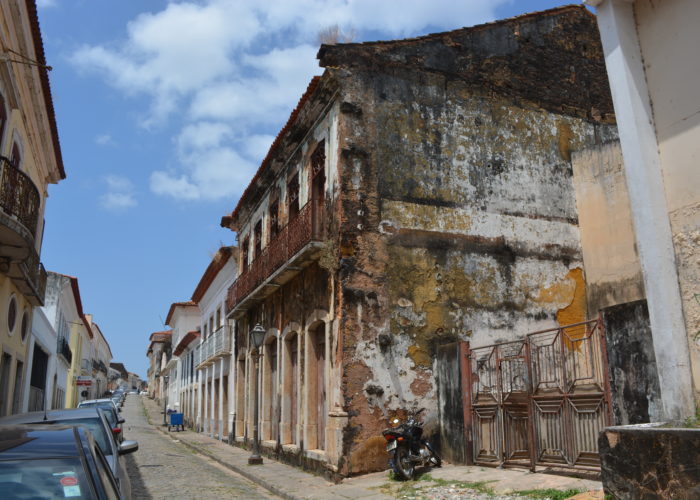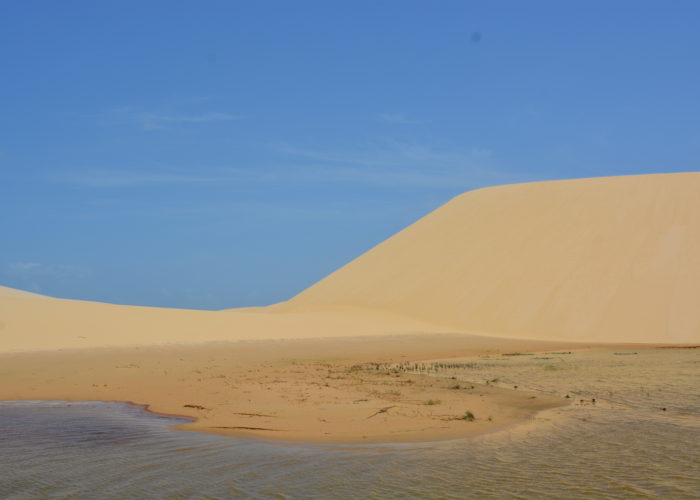Located on Brazil’s northeastern coast, the city of São Luís, with a population of over one million, is the capital of the state of Maranhão. Famous for its colonial architecture and its Afro-Brazilian culture, it boasts a UNESCO World Heritage-listed centre full of crumbling yet charming buildings with bright ceramic tiles. The city’s location at the convergence of rivers and the Atlantic Ocean also makes it a hub for commerce, while its rich cultural heritage and proximity to Lençóis Maranhenses National Park make it a popular destination for tourists.
In Sâo Luís we stayed at Pousada Colonial, a small hotel in one of the old colonial buildings, conveniently located for access to the old historical centre. The long 722km journey on our Dragoman truck from Belém finished with ferry journey across the Baía de Sâo Marcos to Sǎo Luís.

Geography & Climate
São Luís sits on an island between two bays, São Marcos and São José, which create a warm, tropical coastal climate. The city experiences high humidity and temperatures often reaching above 30°C, with a rainy season from January to June and a dry season the rest of the year.

Lençóis Maranhenses National Park, located northeast of São Luís, is a vast expanse of sweeping white dunes punctuated by freshwater lagoons. The park’s geography offers a striking contrast to the humid tropical coast, where sandy dunes stretch for miles inland. The seasonal rains fill these lagoons, creating temporary oases in the otherwise arid expanse.
History & Afro-Brazilian Influence
Founded by the French in 1612, São Luís later came under Dutch control before being firmly established as a Portuguese colony. The blend of these influences is still evident in the city’s architecture and layout. The Portuguese colonial legacy remains strong in the form of the tiled facades and baroque churches. São Luís is also a significant centre for Afro-Brazilian culture, with a large population descended from enslaved Africans brought to the area for plantation work. These legacies shape the city’s traditions, music, and festivals today. Reggae music is deeply embedded in the culture, earning the city the nickname Brazil’s Jamaica. The Bumba Meu Boi festival, a celebration blending African and indigenous traditions.
Economics
São Luís is a major port city, serving as a gateway for the export of iron ore, soybeans, and other commodities. While the colonial centre retains much of its historical charm, most of the city’s middle class have moved to modern suburbs, which host large shopping malls and gated communities. Along the coast, particularly near Atins, enormous wind farms dominate the landscape, part of Brazil’s growing investment in renewable energy.traditions.
Principal Sites of São Luís
Historic Centre & Colonial Architecture
São Luís is famous for its well-preserved colonial architecture. The old centre is a maze of narrow cobbled streets, lined with 18th and 19th-century buildings, many of which are adorned with intricate Portuguese azulejos (decorative tiles) in blues, yellows, and greens.
Rua Portugal stands out as a perfect example of the city’s architectural heritage, with its blue, yellow, and green tiles lending a vibrant charm to the arcade. The streets are full of character, a mix of restored buildings and those in various states of picturesque decay, offering a glimpse into the city’s colonial past.

Palácio dos Leões
The Palácio dos Leões, now the official residence of the state governor, stands on the site of the original French fort built in 1612. This grand white structure overlooks the Baía de São Marcos and is one of the most important buildings in the city, showcasing the history of French, Dutch, and Portuguese control.
Catedral de São Luís
Situated in the heart of the city’s old centre, the Catedral de São Luís (St. Louis Cathedral) is one of the city’s most significant religious landmarks. Its simple yet elegant white façade is typical of colonial churches in Brazil, and its peaceful interior provides a quiet sanctuary from the bustling streets.
Law Courts & Public Buildings
Nearby, the Law Courts and treasury buildings are other fine examples of São Luís’ colonial past. Painted white and surrounded by well-tended gardens, these buildings represent the city’s enduring importance as a regional administrative hub. The old treasury also hosts the Museu Histórico e Artístico do Maranhão, showcasing the region’s art, history, and the famous Bumba Meu Boi festival, which is a celebration of the resurrection of a bull in local folklore.
Convento das Mercês
This former convent is now a cultural centre and museum. Its whitewashed cloisters and spacious interior courtyards provide a tranquil spot to explore. The building houses exhibitions on Maranhão’s history and culture, making it a key site for understanding the region’s heritage.
Museu Histórico e Artístico do Maranhão
The Museu Histórico is housed in one of the grandest colonial mansions in the city, a beautiful example of São Luís’ 18th-century architecture. Inside, you’ll find exhibits on Maranhão’s history, from indigenous artefacts to displays of colonial life.
Afro-Brazilian Influence & Reggae Culture
The streets of São Luís pulse with the rhythms of reggae music. In the evenings, musicians often perform in the squares and street corners of the old town, drawing people into a lively dance. This deep connection with reggae is rooted in the city’s Afro-Brazilian community, which is large and active, particularly in areas like Praia Grande.
Lençóis Maranhenses National Park
Lençóis Maranhenses National Park is one of the most unique landscapes in Brazil. The park, which covers 1,550 square kilometres, is famous for its vast stretches of white sand dunes and the seasonal lagoons that form between them during the rainy season. These clear, freshwater pools are a striking contrast to the surrounding desert-like environment, and visitors can swim in them while enjoying views of the endless dunes.

Wildlife and Boat Trip through the Mangroves along the coast
During our visit, we took a boat trip through the creeks and canals of the park. Scarlet ibis (Eudocimus ruber), with their vivid red plumage, are the stars of the show here, especially when they gather to roost at dusk in the mangroves. The sight of these birds perched like bright ornaments on green trees, creating a Christmas Tree effect in the twilight as the sun sets is unforgettable. Other wildlife in the park includes various fish species, many of which survive the dry season by burying themselves in the sand until the rains return. The park’s diverse ecosystem also supports a range of birdlife, and the lagoons are a refuge for migratory species.

Our journey from São Luís took us along the coast, with three stops over three days.
Barreirinhas
We stayed at Posada do Rio in Barreirinhas, the main gateway to Lençóis Maranhenses National Park. From here, we took a flight over the dunes, offering a bird’s-eye view of the vast expanse of white sand stretching into the horizon.
Atins
In the small village of Atins, we stayed at Posada Irmäo Atins. The area around Atins is peaceful, with a laid-back atmosphere, small fishing communities, and miles of undisturbed coastline. One of the highlights here is the lighthouse, which stands watch over the Atlantic and offers panoramic views of the surrounding dunes, mangroves, and sea.
Parnaíba
Our final stop was Parnaíba, where we stayed at Vila Parnaíba. We took a memorable boat trip through the creeks and canals of the Parnaíba River Delta, starting from Tutóla and ending at a small river port near Titus. It was on this part of the journey where we witnessed the scarlet ibis roosting at dusk.
Final Thoughts
São Luís is a city of contrasts—its colonial architecture reflects a complex history of French, Dutch, and Portuguese influences, while its vibrant Afro-Brazilian culture adds a unique flavour. The decaying beauty of its historic centre is both melancholic and charming, while Lençóis Maranhenses offers one of the most extraordinary landscapes in South America. Whether wandering the tiled streets of São Luís or marvelling at the dunes and lagoons of the national park, this part of Maranhão is a captivating experience.
Dates: 13/10/2018 to 28/10/2018 – Dragoman Days 3 to 8



















